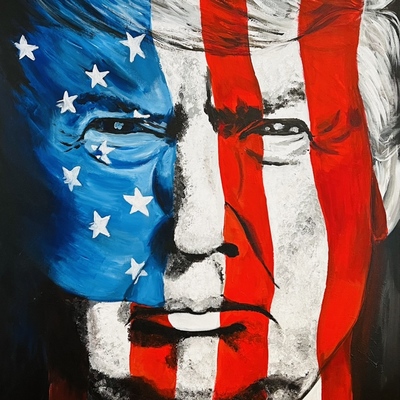
U.S. Consumer Confidence Reaches 5-Month High While Record Tariffs Dampen Economic Outlook
American Consumer Confidence Rises Amid Trade War Shadows
U.S. consumers show cautious optimism as inflation expectations fall, but record-high tariffs cast a long shadow over economic recovery
Consumer confidence in America climbed to a five-month high in early July, a fragile bright spot in an economy still wrestling with the highest tariff rates since the Great Depression and lingering inflation concerns.
The University of Michigan's preliminary Consumer Sentiment Index rose to 61.8 from June's 60.7, marginally exceeding market expectations but remaining 16% below the peak recorded in December 2024. The modest improvement marks what one senior economist described as "a passage from outright fear to nervous muddling-through."

Between Relief and Reality: The Numbers Behind America's Mood
Inside a small grocery store in Michigan's Macomb County, Jennifer Wilkes, 42, examines prices with the practiced eye of someone who's been watching every dollar. "Things aren't getting worse as quickly," she says, calculating her purchase. "But they're still bad."
Wilkes' sentiment mirrors the survey data. Short-run business conditions improved by 8%, but expected personal finances declined 4% compared to June. Meanwhile, inflation expectations dropped notably, with one-year projections falling to 4.4% from 5.0% – the lowest since February.
The July data reveals a consumer caught in an economic contradiction: inflation fears are easing even as the impact of tariffs intensifies. The current average effective tariff rate stands at a historic high exceeding 20%, translating to roughly $2,800 in additional costs per household this year alone.
The Trump Effect: Tax Cuts and Tariff Hikes
The survey closed shortly after President Trump signed his signature tax overhaul, which may have contributed to the modest uptick in sentiment. However, this potential boost finds itself counterbalanced by the administration's aggressive trade policies.
"Every time consumers mention 'tariff' in our interviews, it typically correlates with a 0.3-point drop in the overall index," noted a veteran market analyst with direct knowledge of the survey methodology. "The tariff rhetoric is directly undermining confidence."
China-specific duties have now topped 31%, and rumors of additional increases continue to ripple through markets. Economic models suggest that any fresh round of tariffs would add approximately 30 basis points to 2025 core CPI and reduce real GDP growth by 40-60 basis points.
Market Sentiment: Wall Street vs. Main Street
The modest July improvement in confidence coincides with a stock market rebound that has pushed the S&P 500 to 6,310 – representing a price-to-earnings ratio of approximately 23 times forward earnings, well above the post-financial crisis median of 15.
Yet this market optimism stands in stark contrast to Main Street reality. The survey reveals that perceptions of job availability have deteriorated for six consecutive months straight, while purchasing intentions for homes, vehicles, and appliances remain at decade lows.
"This is an abundance of caution economy," explains a chief economist at a major Wall Street institution. "People are sitting on the sidelines and only buying homes, cars, and appliances if they absolutely must."
The Fed's Dilemma: Inflation vs. Growth
The mixed economic signals have created a policy conundrum for the Federal Reserve. While headline CPI has retreated to 2.7% year-over-year with core at 2.9%, Fed rhetoric has turned "incrementally dovish," according to minutes from the latest FOMC meeting.
Markets are currently pricing in 35 basis points of cuts by December, though many analysts believe the Committee will wait until September to initiate what's expected to be a shallow 50-75 basis point mini-cycle.
"The economy is simultaneously digesting the largest tariff shock since the 1930s while monetary policy is loosening at the margin," observes a former Fed economist. "That is not a recipe for a clean soft landing."
The Investment Landscape: Navigating Uncertain Waters
For investors, the conflicting signals demand a nuanced approach. The Treasury yield curve remains notably inverted, with both 2-year and 10-year yields at 4.44%, sitting at the 82nd and 90th percentiles of their 10-year historical ranges, respectively.
Credit markets appear complacent, with investment-grade and high-yield spreads trading at historically tight levels – the 9th and 20th percentiles of their ranges. This suggests markets may be underpricing the risks associated with a late-cycle economy facing both monetary tightening and tariff pressures.
Gold has maintained its position around $3,340-3,360 per ounce despite dollar strength, indicating persistent geopolitical concerns. Energy markets remain vulnerable to Middle East disruptions, with each $10 movement in Brent crude adding approximately 15 basis points to U.S. headline inflation.
Looking Ahead: Investment Implications
Market veterans suggest several strategic adjustments for the current environment:
"The relief rally seems premature given the underlying economic fundamentals," suggests a chief investment strategist at a leading asset manager. "Defensives like utilities, regulated pipelines, and large-cap consumer staples offer better risk-adjusted potential than tariff-sensitive discretionary retailers and automakers."
For fixed income allocators, selective duration addition financed with options rather than outright longs may provide value. Some managers recommend a 90/10 blend of 10-year Treasuries and agency mortgage-backed securities, financed with rolling three-month T-bill repos.
Alternative assets also merit consideration, with one portfolio manager noting: "Beyond the standard 4-5% gold allocation, platinum's recent breakout remains under-owned and offers leverage to any reshoring-driven automotive catalyst demand."
The Bottom Line: Caution Amid Conflicted Signals
The slight improvement in consumer confidence hardly signals an economic renaissance. With real income growth below 1% and big-ticket purchase intentions depressed, discretionary consumer demand faces what some economists characterize as a "volume recession."
"This is a late-cycle, policy-induced slowdown masked by nominal GDP still exceeding 5%," warns a veteran market strategist. "Current equity valuations already discount a benign outcome that macroeconomic fundamentals don't justify."
For now, America's consumers and investors alike find themselves caught between modest relief and persistent uncertainty – a nervous muddling-through that could quickly deteriorate should tariff tensions escalate further or inflation resurge.
Investment Thesis
| Category | Key Takeaways | Actionable Views |
|---|---|---|
| Consumer Confidence | Modest rebound to 61.8 (still 1σ below mean); inflation expectations remain elevated (1-yr: 4.4%, 5-yr: 3.6%). Transition from "fear" to "nervous muddling-through." | Ignore noise; focus on structural weakness in real incomes and labor sentiment. |
| Macro & Policy | Core CPI sticky (2.9%); tariffs (20%+) risk adding 30bp to 2025 CPI. Fed likely cuts 50–75bp starting Sept. | Expect shallow easing cycle; tariff escalation is key risk (stagflationary). |
| Fixed Income | 2y Tsy (4.44%) rich; curve inverted. IG spreads (80bp) at 9th percentile (tight). HY OAS (291bp) at 20th percentile. | Long TU/short FFV5 (bet on cuts), 5s30s steepener, hedge with IG swaptions. Trim HY CCC exposure. |
| Equities | S&P 500 at 23x forward P/E (above median). Breadth narrow; discretionary demand weak. Real income growth <1%. | Barbell: Overweight defensives (utilities, staples), short tariff-sensitive sectors. Buy SPX put spreads. |
| Commodities & FX | Gold ($3,340–3,360) carries geopolitical premium. Brent volatility impacts CPI. USD supported by trade risks. | Long Dec-25 Brent calls, hold gold core. Long USD vs. KRW/CNY; neutral EUR. |
| Scenarios (6–12m) | Base case (45%): mild disinflation. Risks: tariff escalation (30%, bearish), Goldilocks (15%), hard landing (10%). | Convex hedges (TIPS, equity puts) for tariffs; duration/CDX for hard landing. |
| Strategic Portfolio | Rebalance to high-grade duration (10y Tsy + MBS). Replace IG beta with long/short trades. Hold gold/platinum. Equity net 35% (quality tilt). Election hedge via VIX calls. | Focus on carry, defensives, and convexity. |
Disclaimer: This analysis represents informed opinion based on current market data and established economic indicators. Past performance does not guarantee future results. Readers should consult qualified financial advisors for personalized investment guidance.